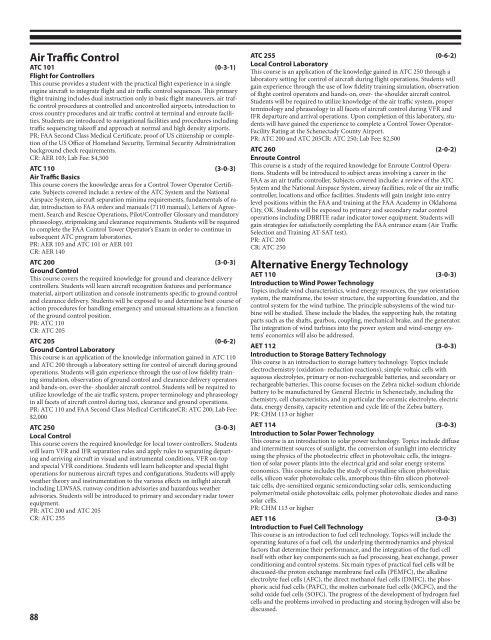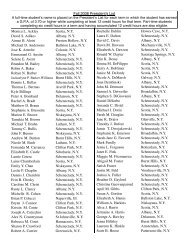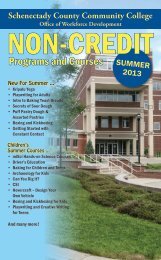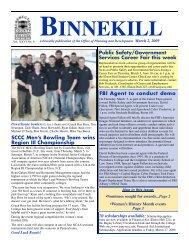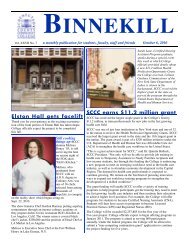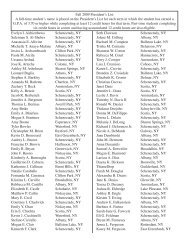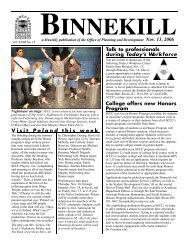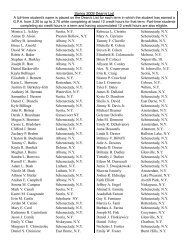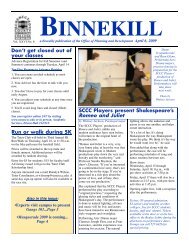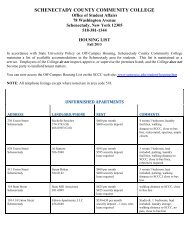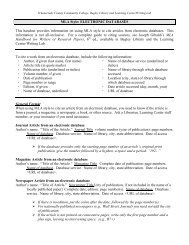CATALOG - Schenectady County Community College
CATALOG - Schenectady County Community College
CATALOG - Schenectady County Community College
Create successful ePaper yourself
Turn your PDF publications into a flip-book with our unique Google optimized e-Paper software.
Air Traffic ControlATC 101 (0-3-1)Flight for ControllersThis course provides a student with the practical flight experience in a singleengine aircraft to integrate flight and air traffic control sequences. This primaryflight training includes dual instruction only in basic flight maneuvers, air trafficcontrol procedures at controlled and uncontrolled airports, introduction tocross country procedures and air traffic control at terminal and enroute facilities.Students are introduced to navigational facilities and procedures includingtraffic sequencing takeoff and approach at normal and high density airports.PR: FAA Second Class Medical Certificate, proof of US citizenship or completionof the US Office of Homeland Security, Terminal Security Administrationbackground check requirements.CR: AER 103; Lab Fee: $4,500ATC 110 (3-0-3)Air Traffic BasicsThis course covers the knowledge areas for a Control Tower Operator Certificate.Subjects covered include: a review of the ATC System and the NationalAirspace System, aircraft separation minima requirements, fundamentals of radar,introduction to FAA orders and manuals (7110 manual), Letters of Agreement,Search and Rescue Operations, Pilot/Controller Glossary and mandatoryphraseology, stripmaking and clearance requirements. Students will be requiredto complete the FAA Control Tower Operator’s Exam in order to continue insubsequent ATC program laboratories.PR: AER 103 and ATC 101 or AER 101CR: AER 140ATC 200 (3-0-3)Ground ControlThis course covers the required knowledge for ground and clearance deliverycontrollers. Students will learn aircraft recognition features and performancematerial, airport utilization and console instruments specific to ground controland clearance delivery. Students will be exposed to and determine best course ofaction procedures for handling emergency and unusual situations as a functionof the ground control position.PR: ATC 110CR: ATC 205ATC 205 (0-6-2)Ground Control LaboratoryThis course is an application of the knowledge information gained in ATC 110and ATC 200 through a laboratory setting for control of aircraft during groundoperations. Students will gain experience through the use of low fidelity trainingsimulation, observation of ground control and clearance delivery operatorsand hands-on, over-the- shoulder aircraft control. Students will be required toutilize knowledge of the air traffic system, proper terminology and phraseologyin all facets of aircraft control during taxi, clearance and ground operations.PR: ATC 110 and FAA Second Class Medical CertificateCR: ATC 200; Lab Fee:$2,000ATC 250 (3-0-3)Local ControlThis course covers the required knowledge for local tower controllers. Studentswill learn VFR and IFR separation rules and apply rules to separating departingand arriving aircraft in visual and instrumental conditions, VFR on-topand special VFR conditions. Students will learn helicopter and special flightoperations for numerous aircraft types and configurations. Students will applyweather theory and instrumentation to the various effects on inflight aircraftincluding LLWSAS, runway condition advisories and hazardous weatheradvisories. Students will be introduced to primary and secondary radar towerequipment.PR: ATC 200 and ATC 205CR: ATC 25588ATC 255 (0-6-2)Local Control LaboratoryThis course is an application of the knowledge gained in ATC 250 through alaboratory setting for control of aircraft during flight operations. Students willgain experience through the use of low fidelity training simulation, observationof flight control operators and hands-on, over- the-shoulder aircraft control.Students will be required to utilize knowledge of the air traffic system, properterminology and phraseology in all facets of aircraft control during VFR andIFR departure and arrival operations. Upon completion of this laboratory, studentswill have gained the experience to complete a Control Tower Operator-Facility Rating at the <strong>Schenectady</strong> <strong>County</strong> Airport.PR: ATC 200 and ATC 205CR: ATC 250; Lab Fee: $2,500ATC 260 (2-0-2)Enroute ControlThis course is a study of the required knowledge for Enroute Control Operations.Students will be introduced to subject areas involving a career in theFAA as an air traffic controller. Subjects covered include: a review of the ATCSystem and the National Airspace System, airway facilities, role of the air trafficcontroller, locations and office facilities. Students will gain insight into entrylevel positions within the FAA and training at the FAA Academy in OklahomaCity, OK. Students will be exposed to primary and secondary radar controloperations including DBRITE radar indicator tower equipment. Students willgain strategies for satisfactorily completing the FAA entrance exam (Air TrafficSelection and Training AT-SAT test).PR: ATC 200CR: ATC 250Alternative Energy TechnologyAET 110 (3-0-3)Introduction to Wind Power TechnologyTopics include wind characteristics, wind energy resources, the yaw orientationsystem, the mainframe, the tower structure, the supporting foundation, and thecontrol system for the wind turbine. The principle subsystems of the wind turbinewill be studied. These include the blades, the supporting hub, the rotatingparts such as the shafts, gearbox, coupling, mechanical brake, and the generator.The integration of wind turbines into the power system and wind-energy systems’economics will also be addressed.AET 112 (3-0-3)Introduction to Storage Battery TechnologyThis course is an introduction to storage battery technology. Topics includeelectrochemistry (oxidation- reduction reactions), simple voltaic cells withaqueous electrolytes, primary or non-rechargeable batteries, and secondary orrechargeable batteries. This course focuses on the Zebra nickel-sodium chloridebattery to be manufactured by General Electric in <strong>Schenectady</strong>, including thechemistry, cell characteristics, and in particular the ceramic electrolyte, electricdata, energy density, capacity retention and cycle life of the Zebra battery.PR: CHM 113 or higherAET 114 (3-0-3)Introduction to Solar Power TechnologyThis course is an introduction to solar power technology. Topics include diffuseand intermittent sources of sunlight, the conversion of sunlight into electricityusing the physics of the photoelectric effect in photovoltaic cells, the integrationof solar power plants into the electrical grid and solar energy systems’economics. This course includes the study of crystalline silicon photovoltaiccells, silicon wafer photovoltaic cells, amorphous thin-film silicon photovoltaiccells, dye-sensitized organic semiconducting solar cells, semiconductingpolymer/metal oxide photovoltaic cells, polymer photovoltaic diodes and nanosolar cells.PR: CHM 113 or higherAET 116 (3-0-3)Introduction to Fuel Cell TechnologyThis course is an introduction to fuel cell technology. Topics will include theoperating features of a fuel cell, the underlying thermodynamics and physicalfactors that determine their performance, and the integration of the fuel cellitself with other key components such as fuel processing, heat exchange, powerconditioning and control systems. Six main types of practical fuel cells will bediscussed-the proton exchange membrane fuel cells (PEMFC), the alkalineelectrolyte fuel cells (AFC), the direct methanol fuel cells (DMFC), the phosphoricacid fuel cells (PAFC), the molten carbonate fuel cells (MCFC), and thesolid oxide fuel cells (SOFC). The progress of the development of hydrogen fuelcells and the problems involved in producting and storing hydrogen will also bediscussed.


